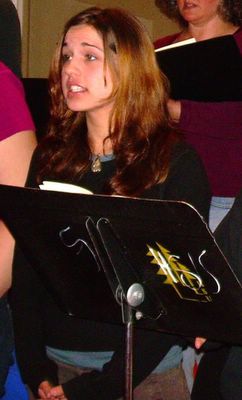Mad River Singers: Program and Director’s Notes Until I Met You (arr. Janis Siegel & Jay Graydon)
Composed by Basie guitarist Freddie Green, and arranged for Manhattan Transfer by Janis Siegel & Jay Graydon. Our performance features Melody Walker, Calista LaBolle, Bernie Steinberg, and Sarah Benzinger as soloists.
Until I Met You is a Grammy Winning song featured on Manhattan Transfer's 1992 CD
Down in Birdland.
MLK (Bono)
A brilliant song with compelling melody and haunting harmony about Martin Luther King by Bono, lead singer of the Irish rock band, U2. Our soloist is Calista LaBolle.
If I Should Lose You (Leo Robin & Ralph Rainge)
From the 1936 movie
Rose of the Rancho, this song was recorded by many artists including Frank Sinatra and Nina Simone. Our version features tenor Bernie Steinberg.
My Heart Is Longing For Your Love (arr. Gregg Smith)
Gregg Smith, a California native transplanted to New York, formed a professional singing group called The Gregg Smith Singers. Smith¹s arrangement of My Heart Is Longing For Your Love is publishedunder the collection entitled Doo-Wop Madrigals. What we have here is a pretty cool Renaissance Madrigal written in jazz ballad style. Our soloist is Jessica Malone.
Shout Blues (Kerry Marsh)
A shout chorus is a common element in many jazz arrangements. Kerry Marsh, vocal jazz director at Sac State, has combined two shout choruses and 12 barimprovisation to make an our first MRT Blues contribution in tonight’s concert. Carmen King, Serena Porter, Matt Brogdon, and Alex Saslow arethe creative team singing scat improvisation.
Tangerine (Victor Schertzinger, & JohnnyMercer)
Tangerine was introduced in the 1942 movie,
The Fleet's In. The most popular recorded version of
Tangerine was made by the Jimmy Dorsey Orchestra with vocalists Helen O'Connell and Bob Eberly, which rose to the top of the Billboard magazine charts that year, and remained in the top ten for fifteen weeks.
If I Only Had a Brain (Harold Arlen & E.Y. Harburg)
The Wizard of Oz movie is dear to the heart of many fans. Ray Bolger’s character, the Scarecrow, is classic. Bolger’s song is a musing lyric about what he would do if he could replace the straw in his head for some grey matter. A similar pleading happens to some students around final exam time.
Baby Driver ( arr. Peter Eldridge & Darmon Meader)
Baby Driver was originally written by Paul Simon, and recorded by Simon and Garfunkel. It is a song characteristic of Simon’s compositional style: a combination of offbeat lyrics and unusual harmonies. Peter Eldrigde & Darmon Meader arranged this song for New York Voices, one of the pre-eminent vocal jazz quartets of our time. Baby Driver is the lead song on the New York Voices CD,
The Songs of Paul Simon. Our rendition features Alex Saslow, and Darius Brotman will deliver a tasty piano solo.
Muddy Water (arr. Michele Weir)
Noted vocal jazz composer, jazz recording vocalist and pianist, Michele Weir, arranged this blues song for jazz choir and multiple soloists. We will feature Melody Walker with help from Jon Walton, Jessica Malone, and Calista LaBolle.

